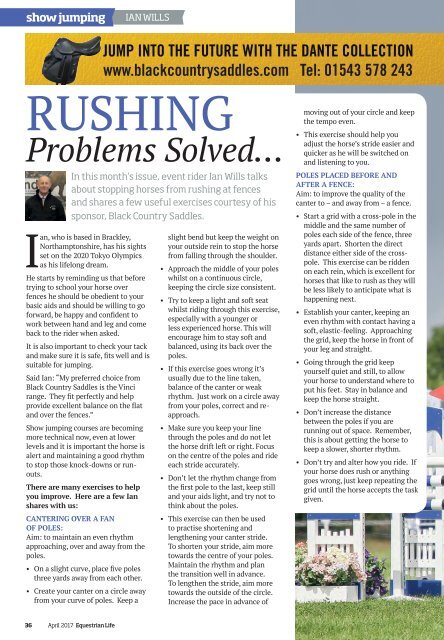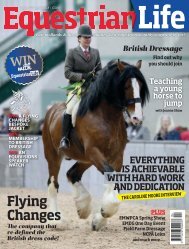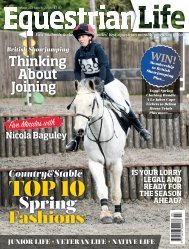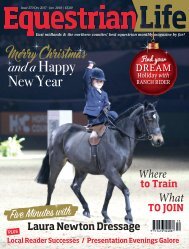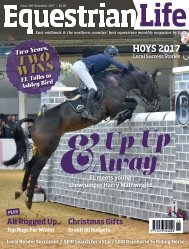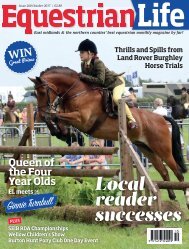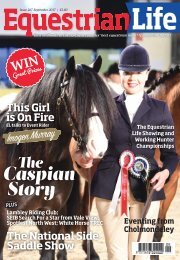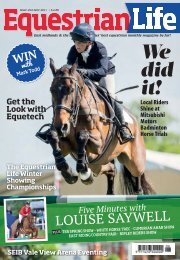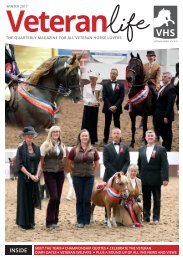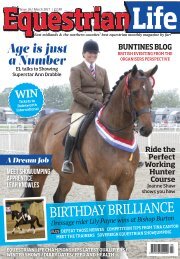Equestrian Life April 2017 Edition
The leading monthly magazine for the East Midlands and Northern Counties
The leading monthly magazine for the East Midlands and Northern Counties
Create successful ePaper yourself
Turn your PDF publications into a flip-book with our unique Google optimized e-Paper software.
show jumping<br />
IAN WILLS<br />
Ian, who is based in Brackley,<br />
Northamptonshire, has his sights<br />
set on the 2020 Tokyo Olympics<br />
as his lifelong dream.<br />
He starts by reminding us that before<br />
trying to school your horse over<br />
fences he should be obedient to your<br />
basic aids and should be willing to go<br />
forward, be happy and confident to<br />
work between hand and leg and come<br />
back to the rider when asked.<br />
It is also important to check your tack<br />
and make sure it is safe, fits well and is<br />
suitable for jumping.<br />
Said Ian: “My preferred choice from<br />
Black Country Saddles is the Vinci<br />
range. They fit perfectly and help<br />
provide excellent balance on the flat<br />
and over the fences.”<br />
Show jumping courses are becoming<br />
more technical now, even at lower<br />
levels and it is important the horse is<br />
alert and maintaining a good rhythm<br />
to stop those knock-downs or runouts.<br />
There are many exercises to help<br />
you improve. Here are a few Ian<br />
shares with us:<br />
CANTERING OVER A FAN<br />
OF POLES:<br />
Aim: to maintain an even rhythm<br />
approaching, over and away from the<br />
poles.<br />
• On a slight curve, place five poles<br />
three yards away from each other.<br />
• Create your canter on a circle away<br />
from your curve of poles. Keep a<br />
JUMP INTO THE FUTURE WITH THE DANTE COLLECTION<br />
www.blackcountrysaddles.com Tel: 01543 578 243<br />
RUSHING<br />
Problems Solved…<br />
In this month’s issue, event rider Ian Wills talks<br />
about stopping horses from rushing at fences<br />
and shares a few useful exercises courtesy of his<br />
sponsor, Black Country Saddles.<br />
slight bend but keep the weight on<br />
your outside rein to stop the horse<br />
from falling through the shoulder.<br />
• Approach the middle of your poles<br />
whilst on a continuous circle,<br />
keeping the circle size consistent.<br />
• Try to keep a light and soft seat<br />
whilst riding through this exercise,<br />
especially with a younger or<br />
less experienced horse. This will<br />
encourage him to stay soft and<br />
balanced, using its back over the<br />
poles.<br />
• If this exercise goes wrong it’s<br />
usually due to the line taken,<br />
balance of the canter or weak<br />
rhythm. Just work on a circle away<br />
from your poles, correct and reapproach.<br />
• Make sure you keep your line<br />
through the poles and do not let<br />
the horse drift left or right. Focus<br />
on the centre of the poles and ride<br />
each stride accurately.<br />
• Don’t let the rhythm change from<br />
the first pole to the last, keep still<br />
and your aids light, and try not to<br />
think about the poles.<br />
• This exercise can then be used<br />
to practise shortening and<br />
lengthening your canter stride.<br />
To shorten your stride, aim more<br />
towards the centre of your poles.<br />
Maintain the rhythm and plan<br />
the transition well in advance.<br />
To lengthen the stride, aim more<br />
towards the outside of the circle.<br />
Increase the pace in advance of<br />
moving out of your circle and keep<br />
the tempo even.<br />
• This exercise should help you<br />
adjust the horse’s stride easier and<br />
quicker as he will be switched on<br />
and listening to you.<br />
POLES PLACED BEFORE AND<br />
AFTER A FENCE:<br />
Aim: to improve the quality of the<br />
canter to – and away from – a fence.<br />
• Start a grid with a cross-pole in the<br />
middle and the same number of<br />
poles each side of the fence, three<br />
yards apart. Shorten the direct<br />
distance either side of the crosspole.<br />
This exercise can be ridden<br />
on each rein, which is excellent for<br />
horses that like to rush as they will<br />
be less likely to anticipate what is<br />
happening next.<br />
• Establish your canter, keeping an<br />
even rhythm with contact having a<br />
soft, elastic-feeling. Approaching<br />
the grid, keep the horse in front of<br />
your leg and straight.<br />
• Going through the grid keep<br />
yourself quiet and still, to allow<br />
your horse to understand where to<br />
put his feet. Stay in balance and<br />
keep the horse straight.<br />
• Don’t increase the distance<br />
between the poles if you are<br />
running out of space. Remember,<br />
this is about getting the horse to<br />
keep a slower, shorter rhythm.<br />
• Don’t try and alter how you ride. If<br />
your horse does rush or anything<br />
goes wrong, just keep repeating the<br />
grid until the horse accepts the task<br />
given.<br />
36 <strong>April</strong> <strong>2017</strong> <strong>Equestrian</strong> <strong>Life</strong>


